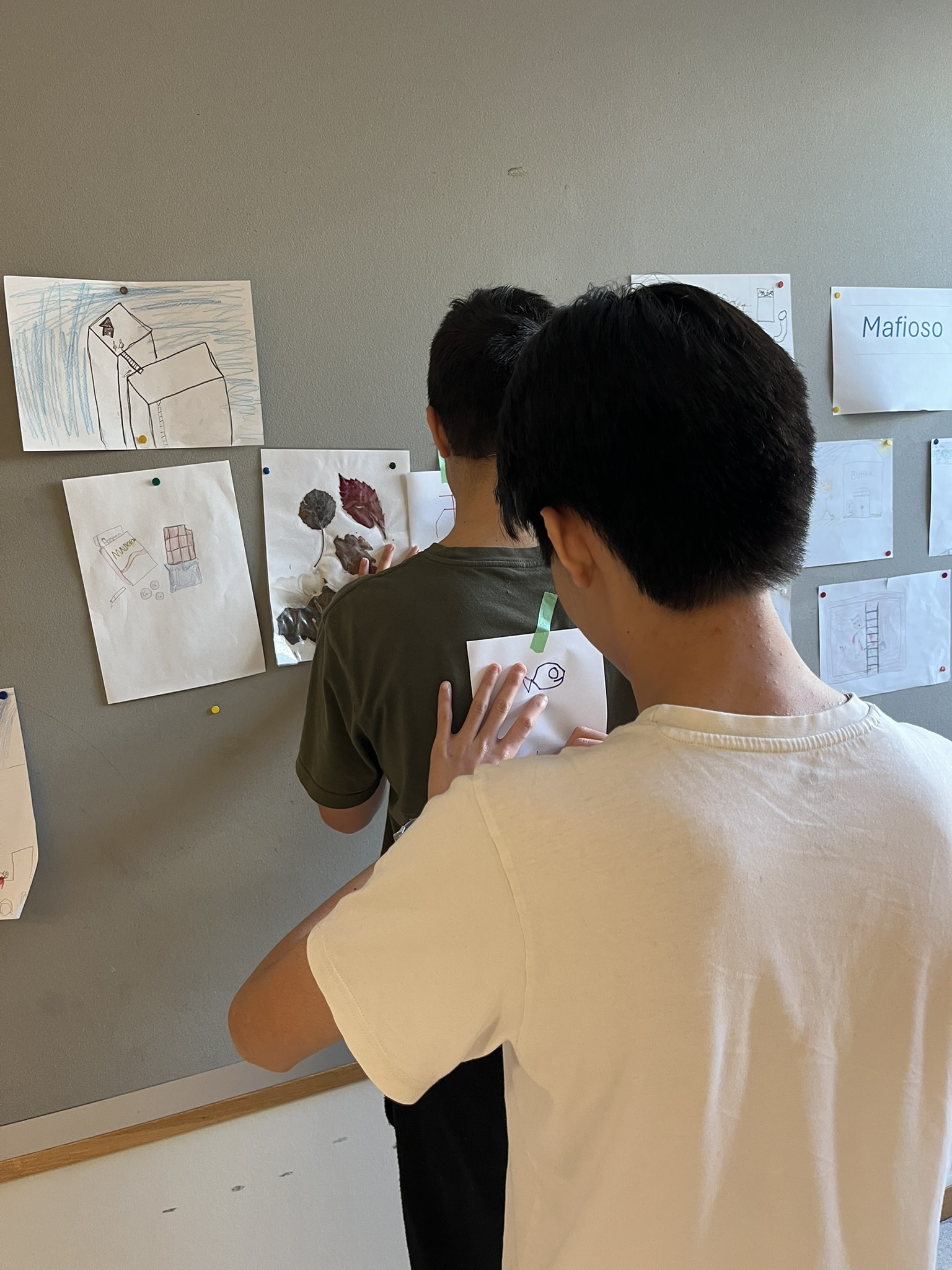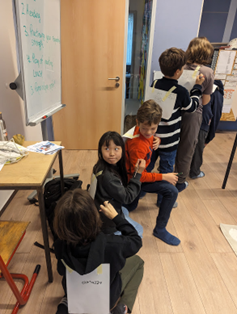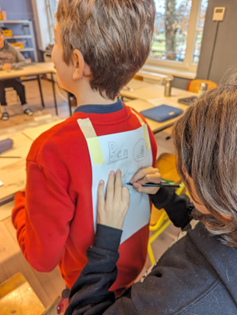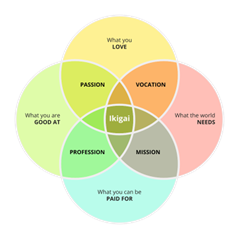Why use this tool?
This tool fosters inner enquiries, with a view to helping find the drive to embrace and embody values that sustain the lives of all living beings. It helps learners identify the role(s) that inspires them personally to act towards climate resilience and regeneration. The tool was developed on the premise that we all have a role to play in fostering climate-resilience and regeneration, and that aligning with the values that move us, finding our signature strength, or discerning our ikigai can lead to a more fulfilling live, as well as to enhanced wellbeing for others and the more than humans.
Activities in this Tool
Activity 3.5.1. Everyday superhero – practicing your signature strength
Activity 3.5.2. Exploring your values
Activity 3.5.3 : Finding your ikigai
Activity 3.5.1 Active listening
Overview
In this uplifting activity, learners explore and celebrate their personal strengths by becoming everyday superheroes. Through creative reflection, peer encouragement, and simple daily actions, they identify and practice their signature strength to boost wellbeing and confidence. With playful movement, inspiring discussion, and imaginative drawing, this session nurtures kindness, resilience, and a strong inner compass—empowering learners to make a positive impact on themselves and the world around them.
Curriculum linkage
- Ethics, Religion & Philosophy, Physical Education & Health
Competences built
- Self-reflection, inner compass, humility, authenticity, empathy
Basic info
- Age range: 6+
- Duration: 45 min + homework
- Group size: Max. 30
- Level of difficulty: Basic
- Materials/space required: Paper, tape, coloured pens
- Location: Large classroom or other large indoor or outdoor space
- Engagement of external stakeholders: Not needed
Prep Work
- Reflect on what your own signature strength is.
Competences/activities to practice first by the teacher:
Steps in the activity
- Who is your superhero?
- Making each other superheroes
- Feeling strong
- Practicing your signature strength
- Imagine a super world
Step 1: Who is your superhero? (10 min)
- Ask the learners who their favorite superhero is and what their strengths are. If they focus on physical strength or supernatural skills such as flying or climbing walls, you can add examples of ‘soft’ strengths (values) such as loyal, courageous, patient, loving (ex: the mother of Harry Potter), caring, kind and curious.
- Ask the learners if there is someone in their life who is like a superhero to them. Invite them to share how/why.
- Write down all the strengths that all the learners share, so they show clearly on a screen/board.
Step 2: Making each other superheroes (15 min)
- Give every learner a paper, and ask them to write “I think you are…” at the top of the page and tape it to their back. This is their superhero cape.
- Give every learner a coloured pen. The learners move slowly around the room and write strengths on each other’s backs (on the paper). The learners walk and write in silence, and you can put on music to make it more fun.
- Before starting to write, establish the rule that it is only allowed to write actual strengths (positive words). If the learners need ideas, they can look at the list of strengths on the screen/board.

Learner writing on another learner’s superhero cape. Photo: Marte Maurabakken/Climate Creativity.
- When the learners are done walking and writing, ask them to sit, look at their paper/superhero cape, and circle the strengths they want to practice. If they find that one of their strengths is missing, they can add it to the paper themselves.
Step 3: Feeling strong (10 min)
- Start with a movement game with the objective of having fun and feeling strong in our bodies. Demonstrate the game with another teacher or a prepared learner before explaining the rules.
- Divide the learners into groups of two (A&B)
- Learner A stands still, while learner B puts their hand softly on top of A’s head. A follows B’s hand movements. When B puts the weight of their hand on A’s head, A moves down towards a squat position. When B lifts their hand, which removes the weight of the hand, A comes back up. Do this for ca. 3 min before you ask the learners to switch roles.
- Invite the learners to share how they felt doing the movement game.
Step 4: Practicing your signature strength (10 min)
- Ask the learners how they want to practice their signature strength. These should be simple things they can do every day for a week. For example, they can practice courage by trying out something new, like eating a new type of food; kindness by helping a sibling; patience by watching the sunset with a parent (if it is before bedtime for the younger learners).
- Encourage learners to practice every day for a week (and follow up every day by asking what they did and if they could feel any change before and after).
- End the exercise by inviting everyone to get up on their feet and do a superhero pose.
Step 5: Imagine a super world
- Introduce the idea of a “super world” where everyone practices their strengths. This would be a utopian world that fully embodies our moral ideas.
- Invite the learners to draw an image of their utopia where they show how the world would look if the strengths they have been practicing were actually practiced by everyone in the whole world all the time. For example: How would the world look if everyone was kind and responsible?
Dos and Don’ts
Do
- Make sure you offer support to learners who are unsure what to write on each other’s ‘capes’. For example, you can give ideas of what you think learners could write and/or explain that spelling is not important in this game. You could give the learners the option to draw instead of writing, if needed.
- Ensure that all learners get a minimum number of strengths written on their paper. One way to ensure this is by asking learners to draw a certain number of boxes/lines on their papers and make sure all boxes/lines are filled.
Don’t
- Don’t say that someone the learners mention is not a superhero, just move on if a learner is making jokes. Invite learners to explain why they think someone is a superhero, but don’t force them to list strengths, it is OK not to find the right words.
- In the end, when learners are invited to do a superhero pose, don’t comment on their pose being “too weak” or “too timid”, their ways of expressing themselves are all OK (as long as it is not causing harm to others).
Adaptations
- Offer multiple ways to participate. Learners can describe strengths using drawings, stickers, photos, or emojis instead of written words. Some may prefer to share verbally or with assistive technology.
- Use pre-filled word banks or visuals. Provide a printed or digital sheet with illustrated strengths or emojis learners can choose from, especially helpful for those with dyslexia, autism, or limited writing skills.
- Structure the “cape” activity with smaller groups. For learners who are overwhelmed by large, noisy settings or struggle with unstructured peer interactions, conduct the cape-writing in groups of 3–4 with adult facilitation.
We invite you to adapt this activity to the specific needs of your learners, including by taking into account their neurodiversity. When adapting tools and activities for neurodivergent learners, please note it is not about treating others how you want to be treated, but how they want to be treated. Ask, listen, and stay open to different ways of learning and engaging.
References
This activity was designed by Climate Creativity.
- Galloway, R., Reynolds, B., Williamson, J. (2016). Strengths-Based Teaching and Learning Approaches for Children. In: Fan, S., Fielding-Wells, J. (eds) What is Next in Educational Research?. SensePublishers, Rotterdam. https://doi.org/10.1007/978-94-6300-524-1_19
- Hiemstra, D., Van Yperen, N.W. The effects of strength-based versus deficit-based self-regulated learning strategies on students’ effort intentions. Motiv Emot 39, 656–668 (2015). https://doi.org/10.1007/s11031-015-9488-8
- Brownlee, Keith, Edward Peter Rawana, and Julia MacArtthur. „Implementation of a strengths-based approach to teaching in an elementary school.“ Journal of Teaching and Learning 8.1 (2012).

Learners are turning each other into superheroes by writing strengths on one another’s capes. Photo by Carmelo Zamora at REAL School Budapest.

Learners are turning each other into superheroes by writing strengths on one another’s capes. Photo by Carmelo Zamora at REAL School Budapest.
Download the Activity Card here
Activity 3.5.2. Exploring your values
Overview
Our individual and collective values are connected, and our values impact how we perceive and respond to climate change. This tool consists in looking into shared humanity, espoused values, culture and paradigms to reflect about our own values, and their links to collective values. The learners can be asked about what they value in others. This exercise can be combined with storytelling and follow-up discussions on how we reflect these values, why not, how they are reflected in our shared cultural values, and how they relate to resilience and regeneration.
Curriculum linkage
- Civics & Social Studies, Physical Education & Health. Ethics, Religion & Philosophy
Competences built
- Self-reflection, presence, inner compass, humility
Basic info
- Age range: 16+
- Duration: 30-60 min
- Group size: Open
- Level of difficulty: Intermediate to advanced
- Materials/space required: None
- Location: Indoors
- Engagement of external stakeholders: No
Prep Work
- Prepare by putting together a list of potential intrinsic (and extrinsic) values.
- Develop a general understanding of values.
Competences/activities to practice first by the teacher:
- No
Steps in the activity
- Clarifying one’s own values
- Exploring other’s values and culture
Steps
Step 1 : Clarifying one’s own values
- Invite the learners to think of a person they respect and admire deeply, but have never met. What are the inner qualities or values that the learners admire most in that person? Note that it is not about what the person did (e.g. activities or professional skills). While learners are free to think of any person they want, you can encourage them to find a nonviolent person who has not inflicted harm on others, if needed.
- Feel free to give an example that would be appealing to learners of the age group you are working with. An example could be Yoda (Star Wars), who displays presence, compassion, courage, self-awareness, openness, oneness, perseverance (“Do or do not. There is no try”; „Name must be your fear before banishing it you can”; „You must unlearn what you have learnt; The greatest teacher, failure is“).
- Ask the learners to write on a paper: ”The qualities/ inner values I admire in (write name of the person you have selected) are ….”.
- After 10 min of individual time/ work, collect the qualities/ inner values they have written down on a board (without asking them about the person they had selected).
Step 2: Exploring other’s values and culture
- Based on step 1, discuss the mentioned values and the existing patterns. What do the listed values say about our shared humanity? And how do they relate to sustainability, climate resilience and regeneration?
- After the identification of the existing patterns, bring the discussion to our current culture, organisations, systems and structures. How are those values reflected, or not, in our every-day life? Why? And what does this mean for sustainability, climate resilience and/or regeneration?
Adaptations
We invite you to adapt this activity to the specific needs of your learners, including by taking into account their neurodiversity. When adapting tools and activities for neurodivergent learners, please note it is not about treating others how you want to be treated, but how they want to be treated. Ask, listen, and stay open to different ways of learning and engaging.
References
- Link to sustainability: UNSDG | 2030 Agenda – Universal Values
- Link to related research and more advanced exercises: Integrity_and_Ethics_Module_2_Ethics_and_Universal_Values.pdf (unodc.org)
Download the Activity Card here
Activity 3.5.3 : Finding your ikigai
Overview
Ikigai is a Japanese concept, generally interpreted as what gives your life meaning or life purpose, a methodology that has become very popular in the West over the last five years. Using the ikigai method can help give a sense of purpose and meaning for learners eager to identify how they can best foster climate resilience and regeneration. This activity is a short version of the Ikigai methodology developed by the Learning Planet Institute, who has tested it with over 3000 workshop participants. Their preliminary research showed a significant increase in participants’ sense of “’meaning/purpose”’ even after a single workshop.
Curriculum linkage
- Extra curricular activities in relation to choosing future studies or career paths
- Civics & Social Studies, Ethics, Religion & Philosophy, Practical & Vocational (Vocational skills), Cross-Curricular & Global Competencies (Entrepreneurial Education).
Competences built
- Integrity, authenticity, originality, self-awareness
Basic info
- Age range: 12+
- Duration: 30 min – 2 hours
- Group size: Open
- Level of difficulty: Basic
- Materials/space required: Writing material.
- Location: Indoors
- Engagement of external stakeholders: No
Prep Work
- No
Competences/activities to practice first by the teacher:
- No
Levels in the activity
- Try it out
- Dive deeper
Levels
Level 1: Try it out
- IKIGAI is a Japanese concept that can be interpreted as ‘life’s goal’ or ‘what makes life worth living’. The process for individuals to find their Ikigai is based on answering 4 main questions:
- What are you passionate about? What do you love?
- What does the world need?
- What are you good at?
- What can you be paid for or find resources for?
- To try it out with learners, you can use the diagram below, and have them fill out each circle, and then cross sections, of the diagram individually with their own ideas. The Ikigai at the centre will emerge at the end of the process.

- Invite learners to share their ideas for their own Ikigais in small groups to hear about others’ ideas and further reflect, develop or refine their own ideas.
- Invite learners to reflect on how their Ikigai is connected to the global ecological crisis, including growing climate resilience and fostering regeneration.
- Invite learners to regularly go back to their Ikigai and keep reflecting on the four main questions, allowing them to evolve and add new ideas to the diagram.
Level 2: Dive deeper
- In order to dive deeper into the exercise, you can invite learners to do the exercise by asking them some follow up questions in relation to the 4 main questions, or giving them the following directions:
- What are you passionate about? What do you love? => Explore your past experiences to define what truly motivates you and drives you.
- What does the world need? => Mobilize your experience to reflect on the (ecological) causes that matter to you the most. How can you integrate those causes into your personal and professional life?
- What are you good at? => Assess your unique skills and how they can be applied to make a difference. Feel free to consider unconventional paths that leverage your strengths.
- What can you be paid for or find resources for? => For older learners (15+), invite them to write their ideal job description: specify the work environment that best supports your well-being and productivity, define the roles and responsibilities that align with your skills and passions.
- Those different steps can help learners clearly define their Ikigais. This can be done by inviting learners to craft a unique statement that captures their Ikigai, knowing that it will evolve with the changing professional and personal aspirations of learners.
- Invite learners to discuss their Ikigai, and the final statement, in small groups in order to refine them.
- Invite learners to find other learners whose unique statement resembles theirs so as to form a small group and meet regularly. In a small group, learners can support one another, including to find the resources they need to fully implement their respective Ikigais.
Adaptations
We invite you to adapt this activity to the specific needs of your learners, including by taking into account their neurodiversity. When adapting tools and activities for neurodivergent learners, please note it is not about treating others how you want to be treated, but how they want to be treated. Ask, listen, and stay open to different ways of learning and engaging.
References
This activity is based on the method developed by the Learning Planet Institute and has been adapted for CLARITY by One Resilient Earth.
Research carried out by the Learning Planet Institute on the Ikigai pedagogy:
- https://www.learningplanetinstitute.org/en/ikigai-2/
- https://lpi-projects.webflow.io/ikigai-exclusive-access
